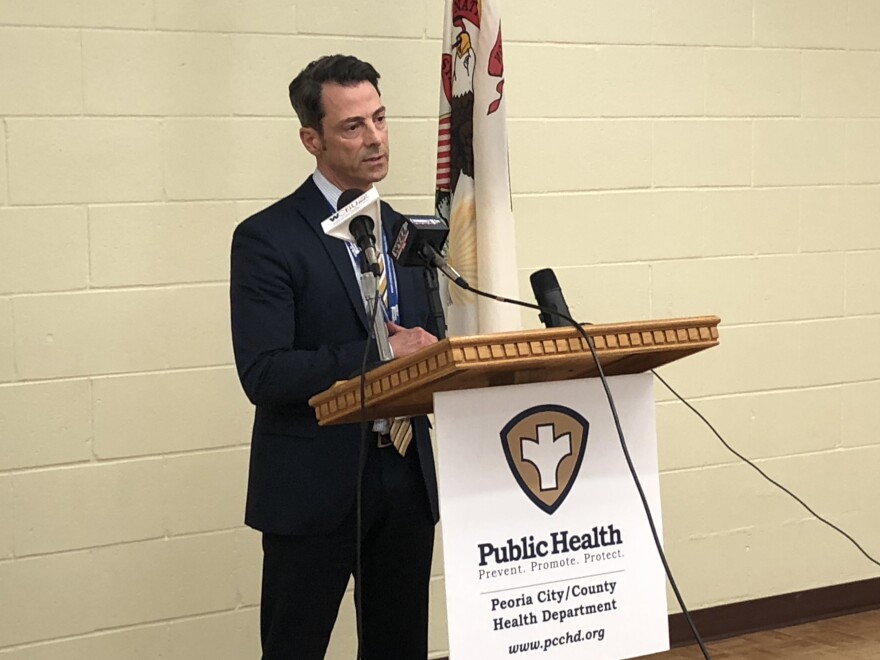The percentage of adolescents and youths among active COVID-19 cases in the Tri-County surged more than 8% in the past week, as the region’s daily average for new cases climbed back above 100.
Peoria City/County Health Department Administrator Monica Hendrickson said 38.5% of area residents currently hospitalized or isolating at home with coronavirus infections are in the 0-19 age range, up from just under 30% a week ago.
“This population is accounting for the majority of our active cases, and because of that, we have to recognize the importance of getting them care as we go into the fall,” she said during the weekly health department briefing Thursday at the Noble Center.
Hendrickson said the 10-19 age range makes up 25% of the active cases, despite those 12 and over being eligible for COVID-19 vaccines. She said a majority of the region’s 777 new cases over the past week involve unvaccinated individuals.
“If you look at the trajectory of cases, and you first group it by age range and then you group it by vaccinated versus unvaccinated, the sharpest incline that we have seen is unvaccinated youth,” said Hendrickson. “So again, if you have a child that is between the ages of 12 and 19 and medically able to get vaccinated, get vaccinated.”
Figures from the three health departments show Peoria, Tazewell, and Woodford counties combining for 934 residents with COVID-19 in home isolation, while Peoria-area hospitals have 40 infected patients. Hendrickson said 13 intensive care unit beds are in use for COVID-19.
Illinois Department of Public Health vaccination data updated earlier Thursday show the region at 49.5% of residents fully vaccinated, with Peoria County at 49.3%, Tazewell at 49.6%, and Woodford at 47.3%.

Michael Wells, president of OSF HealthCare Children’s Hospital of Illinois, said children with COVID infections are frequently asymptomatic or experience a milder reaction to the disease. He said the daily average for admitted COVID-positive patients has remained in the 0-3 range.
“Some children’s hospitals (are) reporting a significant surge in their COVID in-patient population, so much so that their capacity is challenged. We have not seen that at the Children's Hospital of Illinois, fortunately,” said Wells, who noted the hospital has seen a significant uptick in kids with other infectious illnesses such as RSV (respiratory syncytial virus) and rhinovirus.
“Many of the kids that we're seeing are very sick, that has presented some challenges in terms of our bed capacity, especially in our intensive care beds,” he said.
Dr. Keith Hanson, a pediatrician at the Children’s Hospital, said the seasonal uptick in non-COVID respiratory illnesses like RSV is earlier than normal, stressing the need for testing to determine what illness a child might have.
“Though we’re not seeing many kids admitted with severe COVID, the ones that we have seen tend to be teenagers that are unvaccinated and have other medical comorbidities, which we're kind of seeing nationwide as well,” said Hanson. “RSV, on the other hand, when kids are hospitalized, that tends to be younger patients, typically less than age 2.”
Hendrickson said attributing the COVID spike among kids on their return to school would be unfair.
“There are more congregate settings for children of that age, regardless of just school alone, which is much more indoor, but other school-related activities: sports, dance teams, things of that independent from just a school setting,” she said.
Wells said while the number of COVID patients at the Children’s Hospital is low, the concern remains high because many of the kids there have chronic illnesses that make them especially vulnerable.
“We're getting kids from across all of the state, and those are the kids that are being treated for cancer, (and) kids with severe asthma or other chronic illnesses, congenital heart defects,” said Wells. “Those are the kids that are at great risk, so we just encourage people to protect them — and if it's not for yourself, do it for them.”


